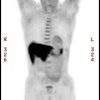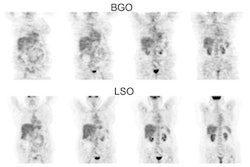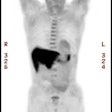J Thorac Cardiovasc Surg 2000 Dec;120(6):1085-92
The utility of positron emission tomography for the diagnosis and
staging of recurrent esophageal cancer.
Flamen P, Lerut A, Van Cutsem E, Cambier JP, Maes A, De Wever W, Peeters M, De Leyn P, Van
Raemdonck D, Mortelmans L.
OBJECTIVE: To study the utility of whole-body positron emission tomography with
(18)F-fluoro-deoxy-D -glucose (FDG-PET) for the evaluation of recurrence after curative
resection of cancer of the esophagus or gastroesophageal junction. METHODS: Forty-one
patients with a clinical or radiologic suspicion of recurrent disease underwent
conventional diagnostic work-up, including a spiral computed tomographic scan, an
endoscopic ultrasound, and a dedicated whole-body FDG-PET. PET lesions were classified as
equivocal or suspicious recurrence. The conventional diagnostic work-up and PET findings
were correlated with pathology or with radiologic and clinical follow-up. Equivocal
lesions were classified as positive. RESULTS: Forty recurrences were found in 33 patients.
The lesions were perianastomotic (n = 9), regional (n = 12), and at distant sites (n =
19). For the diagnosis of a perianastomotic recurrence, the sensitivity, specificity, and
accuracy of FDG-PET were 100%, 57%, and 74%, versus 100%, 93%, and 96% for conventional
diagnostic work-up, respectively (P = not significant). False-positive PET lesions were
found in patients with a progressive anastomotic stenosis requiring repetitive endoscopic
dilatation. For the diagnosis of regional and distant recurrences, the sensitivity,
specificity, and accuracy of PET were 94%, 82%, and 87%, versus 81% (P = not significant),
82% (P = not significant), and 81% (P =.0771) for conventional diagnostic work-up. All
false-positive PET lesions (n = 4) had been reported as equivocal. On a patient base, PET
provided additional information in 11 of 41 (27%) patients. A major impact on diagnosis
was found in 5 patients with equivocal or negative findings on complete diagnostic work-up
in whom PET provided a true-positive diagnosis. In 5 other patients the diagnosis was
staged upward from localized to extended recurrent disease, and in 1 patient with an
equivocal complete diagnostic work-up, PET correctly excluded malignancy. CONCLUSION:
FDG-PET allows a highly sensitive diagnosis and accurate whole-body staging of symptomatic
recurrent esophageal cancer. Further studies in asymptomatic patients are needed to assess
the potential benefit on survival.






